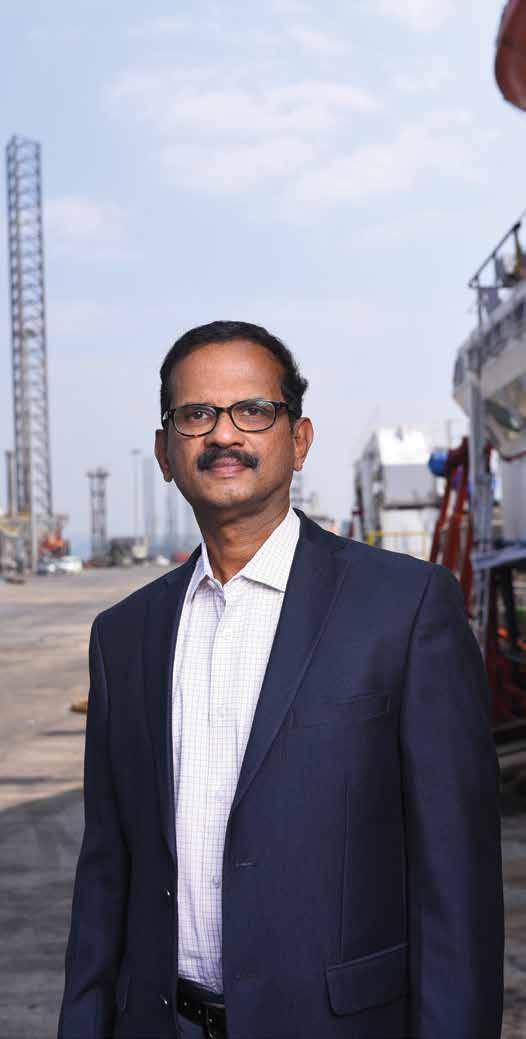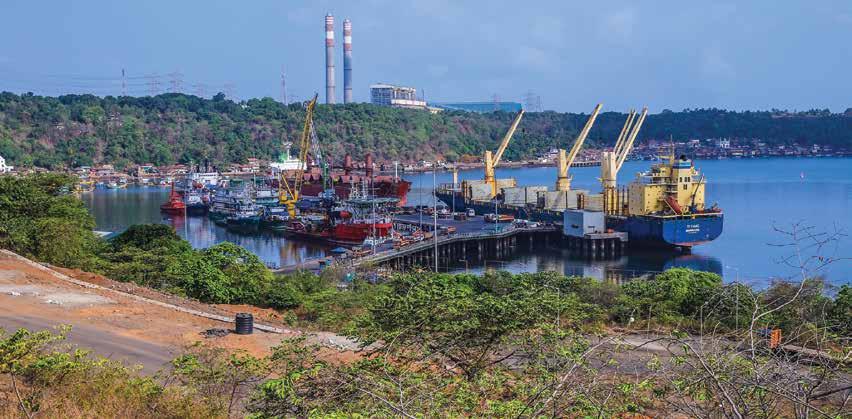
9 minute read
C P Jayakrishn an, CEO, Angré Port
C P Ja yak rish nan
We continue to operate at encouraging pace
Advertisement
Angre Port, the most sheltered all-weather port in the Konkan region, has been bucking the trend amid COVID-19 by efficiently handling 138,000 tonnes of different types of cargo from March till June. Recently, the port completed its first and highly successful year of operations during which it handled more than 500,000 tonnes of cargo, made possible due to the several capabilities the port has built to enable hassle-free movement and storage for all types of cargo.
C P Jayakr ishnan, Chief Exec ut ive Officer ,
Angr é Port in an exclusive interview with Ritika Arora Bhola , informs more on the port’s role as an end-to-end logistics services facilitator, ensuring timely movement of cargo and helping optimise material handling costs, as they continue to support over two dozen large and small local businesses across the state of Maharashtra.
What’s the current situation at AngréPort following the COVID-19 lockdown? How are you reacting and responding to the scenarios? At the start of the outbreak, we were quick to enable business continuity plan ning to optimise our fixed cost base to the tune of 40 per cent during the lockdown, with no effect on service levels to clients. The entire business development, pro curement, accounting, and legal teams have been set up with the requisite col laboration tools to work from home across multiple geographies. This has yielded success to the extent that we are still continuing with the remote working model as much as possible.
Additionally, the downtime has al lowed the otherwise busy port staff to undergo online trainings, evaluate their effectiveness over the past year, and define targets, objectives and key re sponsibilities for the coming season.
We continue to operate at encouraging pace, largely handling essential commodities. We expect cargo move ment through the port to pick up as the country continues to unlock markets in a phased manner.
How are you managing your logistics network and supply chain operations in terms of creating value for customers? From March to June 2020, Angré Port has handled 138,000 tonnes of different types of cargo. The port has been sup porting over 20 large and small local businesses across the state of Maharash tra, ranging from sugar, cement, manufacturing and industry raw materials.
We have always been working as an end-to-end port operator for customers, ensuring timely and safe movement of their cargo, and helping them optimise their material handling cost. Our perfor mance in H1 2020 has been good, with 241,000 MT of cargo being handled. We now aim to achieve 400,000 MT of cargo movement in H2 2020, considering postCOVID forecasts.
Kindly elaborate on the types of cargo being moved both nationally and internationally since lockdowns started. We are currently handling bulk, breakbulk, steel and liquid cargo. Sugar and cement raw materials were major com modities that we handled just before the COVID-19 outbreak. Since monsoons started, sugar handling has stopped. The next season will commence from September, again depending on the rains. Cement sales have also taken a hit, forcing manufacturers to slow down production. All this, in turn, has im pacted port volumes. How is the port handling pressure during these times of emergency? Conversely, what do you see as the biggest untapped opportunities? Angré Port, like any other trade establishment is going through challenges that it has never envisaged. This is also a time when we could introspect at our internal activities like fixed costs, insurance, man power training, operational optimisation, etc. in more detail. As such, we have used this opportunity to fine tune our internal processes and SOPs.

We feel supply chain management and costs are going to be much more significant, than it is already, as items on the risk dashboard for majority of com panies. Angré Port could be a partner to such companies in its hinterland and bring the much-needed assurance and stability in the long-term service, price and deliverables.
Ports will no longer be a place where cargo just transits through, but it will evolve to become an integral part of the larger value chain where it will also contribute in a way partnering with clients in areas of cost management. That said, we are also working with our clients to introduce an integrated logis tics solution to their requirements, ultimately taking care of everything from origin to destination. What you see as the major challenges the global maritime sector is currently facing? It wasn’t until March that the global shipping sector started to really feel the impact of the COVID-19 pandemic. It was from then that all sectors including shipping, which was hit by slowing de mand in goods’ production, exports and oil, tumbled to new lows. The most sig nificant affected are the large crude tankers and bulkers.
China is a major importer of crude oil, usually through VLCCs, so the re duction in economic activity in China had a negative demand effect on crude tankers.
The container sector also signifi cantly relies on China; it too was impacted by the shortfalls. Containers are the most closely linked to econom ic activities which is down globally. The container sector is naturally less liquid, but the world has seen a reduc tion in rates.
I believe the coming months will be increasingly harsh for the global mari time sector, forced to operate in constraints and limited ways. This is not going to be the sole result of the corona virus pandemic but rather a ripple effect of its spread, the introduction of the 2020 sulphur cap by the International Mari time Organisation (IMO), and the failed implementation of the US-China Phase I trade agreement.
Tell us about the superior infrastructure and technologies installed at the port for supporting efficient supply chain operations– cargo handling and movement. Angré Port boasts of a robust infrastructure to ensure hassle-free movement and storage for all types of cargo. The

port, since commencement of its operations, has developed 500,000 square feet of open storage yards for receiving car go; 200,000 square feet of covered warehousing space; 100,000 square feet of paved open storage yards for handling sensitive cargo; and over 32,000 kilolitre of liquid storage capacity.
The port is well-equipped to provide top-notch marine, cargo and storage fa cilities, and in-house services that enable clients to enjoy a single-window, end-to-end service from the port right up to their factories or markets. We have moved 80,000 tonnes of cargo during the past year, with the port taking end-toend responsibility for movement of ship ments from origin to destination. Services under this model include managing transportation, storage and cargo operations at third party ports, charter ing of vessels for coastal cargo movement, and ensuring delivery or pickup within a guaranteed lead time of the required quantity to an operational cli ent location, thereby eliminating client’s storage needs.
Apart from the COVID-19 led lockdown that had an adverse impact on cargo movement, what were the other factors responsible? The nationwide restrictions imposed on the movement of manpower and goods during the lockdown impacted the smooth movement of cargo to and from the hinterland. We faced shortage of equipment operators and drivers as a sizeable percentage of the on-ground workforce were travelling back home.
The challenge was compounded by uncertainty over the expected duration of the lockdown and the resulting eco nomic slowdown thereafter. Postponement in economic consumption had a knockon effect on curtailing clients’ sourcing plans for the near-to-medi um term.
Looking at the current changing environment, what’s most critical to your mind for Angréport to succeed? We anticipate an upsurge in the demand for pharma and agri culture products, food products, garments, chemicals, once the pandemic is over. The increase in infrastructure spending by the government will result into larger order books for clients in al lied sectors, such as the cement industry.
The port, since commencement of its operations, has developed 500,000 square feet of open storage yards for receiving cargo; 200,000 square feet of covered warehousing space; 100,000 square feet of paved open storage yards for handling sensitive cargo; and over 32,000 kilolitre of liquid storage capacity.
Over the medium term, demand will stabilise close to pre-lockdown levels, with increased shipments and greater reliance on ports for quick and efficient handling of cargo. Angré Port is wellpositioned and amply equipped to cater to the increase in demand post-lockdown and remains committed as ever to serv ing its clients in the best possible manner.
By when do you anticipate the port to achieve pre-COVID levels of business and volumes? How will you strategise to sustain this growth? Unlike large ports, Angré Port’s customer base is a niche and focussed group of industries in the immediate hinterland. Although it is difficult to put an exact date to when we will be able to handle cargo to our projected level for this year, we are sure that when the overall economic activity in the region moves ahead from the current slow down, the demand generated will put in motion the movement of cargo through the port as well.
Our customers have known us for our service and commitment to the deliverables. Even when the outbreak was at its peak, we continued support ing our customers with their daily despatches and movement, as we have the capacity to handle our customers’ re quirements efficiently.
We will continue to do that and look for long-term business partners who would want to utilise and subscribe to the port’s advantages and superior in frastructure.
Additionally, we would look to utilising the port’s backup of 280-acre industrial land available for setting up strategic businesses such as mega ware houses, port-based industries, logistics parks, and tank terminals.
The Ministry of Shipping had announced a host of measures for stakeholders across the port sector to boost ocean trade. What are your expectations from the Centre and subsequent suggestions? When it comes to a private port, there is very little that it can ask as support from the government. However, for trade lanes to be opened sooner and to be more effi cient, we request the decision makers to enable them through technology.
We suggest the industry to accept elec tronically generated trade documentation, we urge moving on to a digital platform where issues of physical documentation like original bill of lading (BL) and final invoice, or payment by cash are taken care of as they are currently slowing down the process and also evidently risking staff to a person-to-person contact.
Also, the stakeholders of the trade industry such as carriers, exporters and importers should be issued a mandate to adopt and use platforms for electroni cally generated trade documentation. On a wider note, this could be across stake holders and across nations. Though some of the larger players have developed and moved on to their own systems, the need is greater integration with other third party or government systems.











